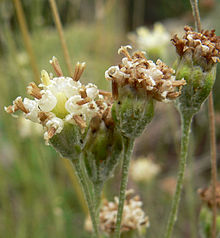| Hymenopappus filifolius | |
|---|---|

| |
| Hymenopappus filifolius var. eriopodus | |
| Conservation status | |
 Secure (NatureServe) | |
| Scientific classification | |
| Kingdom: | Plantae |
| Clade: | Tracheophytes |
| Clade: | Angiosperms |
| Clade: | Eudicots |
| Clade: | Asterids |
| Order: | Asterales |
| Family: | Asteraceae |
| Genus: | Hymenopappus |
| Species: | H. filifolius |
| Binomial name | |
| Hymenopappus filifolius Hook. | |
| Synonyms | |
Synonymy
| |
Hymenopappus filifolius is a North American species of flowering plant in the daisy family known by the common names fineleaf hymenopappus and Columbia cutleaf. It is native to western and central North America from Alberta and Saskatchewan south as far as Chihuahua and Baja California.
Hymenopappus filifolius grows in a number of habitats, often in arid regions. The plant is variable in appearance and there are a great number of varieties of the species. It is a taprooted perennial herb growing as a small clump on the ground to an erect spray of stems up to a meter (40 inches) tall. Almost all of the leaves are located at the base of the plant in a woolly gray-green patch. They are up to 20 centimeters (8 inches) long and are divided into blunt, thready leaflets. They are glandular and thinly hairy to quite woolly, and dark green under the coat of white wool. The stem ends in a branching inflorescence of knob-shaped discoid flower heads. They are filled with golden yellow or white disc florets. There are no ray florets.
There are many varieties, including:
- Hymenopappus filifolius var. cinereus - Arizona, Colorado, Utah, New Mexico, Texas
- Hymenopappus filifolius var. eriopodus – a white-flowered variety native from California, Nevada, Utah
- Hymenopappus filifolius var. filifolius – Idaho, Oregon, Washington
- Hymenopappus filifolius var. idahoensis – Idaho
- Hymenopappus filifolius var. lugens – Arizona, California, Nevada, Utah, New Mexico, Baja California
- Hymenopappus filifolius var. luteus – Utah, Wyoming, Colorado
- Hymenopappus filifolius var. megacephalus – California, Nevada, Utah, Arizona, Colorado
- Hymenopappus filifolius var. nanus – Arizona, California, Nevada, Utah
- Hymenopappus filifolius var. nudipes – Utah, Wyoming
- Hymenopappus filifolius var. parvulus – Colorado
- Hymenopappus filifolius var. pauciflorus – Utah, Arizona, Colorado
- Hymenopappus filifolius var. polycephalus – Alberta, Saskatchewan, Colorado, Kansas, Montana, Nebraska, North Dakota, South Dakota, Wyoming
- Hymenopappus filifolius var. tomentosus – Utah
Uses
The Zuni people apply a poultice of chewed root with lard to swellings. They also drink a warm decoction of the root as an emetic. They also use the root as chewing gum.
References
- The Plant List, Hymenopappus filifolius Hook.
- Biota of North America Program, 2014 county distribution map
- SEINet, Southwestern Biodiversity, Arizona chapter photos, description, distribution map
- ^ Flora of North America, Hymenopappus filifolius Hooker, 1833.
- Stevenson, M. C. 1915 Ethnobotany of the Zuni Indians. SI-BAE Annual Report #30 (p. 54, 55)
- Stevenson, p.68
External links
- Jepson Manual Treatment, University of California
- United States Department of Agriculture Plants Profile Archived 2012-02-10 at the Wayback Machine
- H. filifolius Calphotos Photo gallery, University of California
- var. eriopodus Calphotos Photo gallery, University of California
| Taxon identifiers | |
|---|---|
| Hymenopappus filifolius |
|
This Asteroideae article is a stub. You can help Misplaced Pages by expanding it. |
This Medicinal plants-related article is a stub. You can help Misplaced Pages by expanding it. |
This vegetable-related article is a stub. You can help Misplaced Pages by expanding it. |